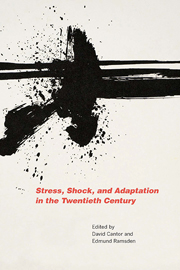Book contents
- Frontmatter
- Contents
- Acknowledgments
- Introduction
- Part One Packaging Stress
- Part Two Trauma and Acute Stress
- Part Three War
- 5 “Stress” in US Wartime Psychiatry: World War II and the Immediate Aftermath
- 6 The Machinery and the Morale: Physiological and Psychological Approaches to Military Stress Research in the Early Cold War Era
- Part Four Work
- Part Five Managing Stress
- Part Six Surveilling Stress
- List of Contributors
- Index
5 - “Stress” in US Wartime Psychiatry: World War II and the Immediate Aftermath
from Part Three - War
Published online by Cambridge University Press: 05 April 2014
- Frontmatter
- Contents
- Acknowledgments
- Introduction
- Part One Packaging Stress
- Part Two Trauma and Acute Stress
- Part Three War
- 5 “Stress” in US Wartime Psychiatry: World War II and the Immediate Aftermath
- 6 The Machinery and the Morale: Physiological and Psychological Approaches to Military Stress Research in the Early Cold War Era
- Part Four Work
- Part Five Managing Stress
- Part Six Surveilling Stress
- List of Contributors
- Index
Summary
Introduction: World War II as a Watershed
In the developing literature on the history of “stress,” scholars over the past two decades have begun to point to World War II as a major turning point. Gerald Grob and Robert Kugelmann, for example, both writing in the early 1990s, clearly stated that the war served as a watershed for American psychiatrists. Grob claimed, “Many psychiatrists … came to some novel conclusions … [one of which was] that environmental stress associated with combat contributed to mental maladjustment…. That environmental factors played a major role in the etiology of mental disorders was to be reiterated by a generation of psychiatrists who served in the military during World War II and assumed positions of leadership in the postwar era.” Kugelmann insisted, “Stress comes into being as a discourse and experience during the Second World War…. Only in the 1940s did it become an explicit topic for research. Only then did it enter the public arena and progressively get absorbed by the general public as a lesson derived from the medical and psychological sciences.” Since their publications other scholars have followed Grob's and Kugelmann's lead, and it is now increasingly believed that through grappling with stress American wartime psychiatrists initiated a period in which stress concepts and stress research became central in American psychiatry and popular culture.
My chapter adds to this interpretive trend and also explores several new historical dimensions.
- Type
- Chapter
- Information
- Stress, Shock, and Adaptation in the Twentieth Century , pp. 121 - 141Publisher: Boydell & BrewerPrint publication year: 2014



